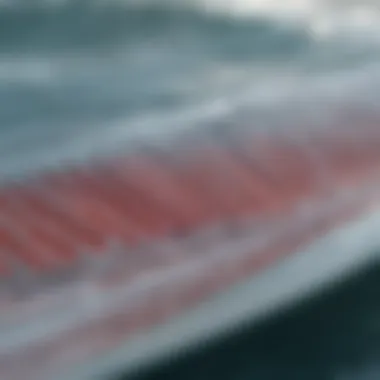Hydro Tech Fins: Transforming Surfboard Performance


Intro
Surfing has always been a dynamic sport, evolving with technology and trends. Recently, hydro tech fins have caught the eye of both casual surfers and professionals alike, signaling a significant shift in surfboard performance. These fins aren’t just pieces of plastic or fiberglass; they are finely tuned instruments that directly affect how a surfboard behaves on the water. With innovations that cater not just to speed but also to stability and maneuverability, it's no wonder surfers are keen to explore these advancements.
Understanding hydro tech fins requires diving into the materials used, the design intricacies, and how such elements interplay with various surfboarding techniques. The advances in this area also shed light on environmental considerations that are becoming increasingly important in the sporting world. This article peels back the layers of design improvements and their real-world implications for surfers of all levels, from beginners riding small waves to seasoned athletes tackling formidable swells.
Surf Gear and Equipment
The world of surf gear has witnessed a remarkable transformation over the years. As surfers, we are constantly on the lookout for equipment that augments our experience on the waves. Hydro tech fins have emerged as a game-changer in this landscape. Let’s delve deeper into the innovations and accessories that complement these advances:
Latest Surfboard Technologies
Modern surfboards are no longer merely made from basic materials. The advances in hydro tech fins reflect a broader trend in surfboard technology, which serves to enhance performance and durability. Today's fins are crafted from materials like carbon fiber and advanced polymers, which allow for more flex and responsiveness. These improvements are not just for the elite surfer. Here are some examples of relevant technologies:
- Hydrodynamic shapes that cut down water resistance, enhancing speed.
- Modular fin systems, allowing surfers to swap components based on wave conditions.
- Sustainable manufacturing techniques that reduce environmental footprints, such as eco-friendly resins.
Essential Accessories for Surfers
No gear setup is complete without the right accessories. When it comes to hydro tech fins, various accessories can significantly influence the overall surfing experience. Consider these:
- Surfboard Leashes: Keeping your board close means less hassle in the water.
- Fins Bags: Protect your investments from dings and damage by carrying fins in padded bags.
- Traction Pads: They enhance grip beneath your feet, allowing for a more secure stance while you ride.
These accessories, when paired with innovative fins, can substantially enhance performance and smoothen the overall experience.
"Every part of your surf setup contributes to your ride on the waves. Choose wisely."
Techniques and Skills
Understanding the tools of surfing is just half the battle. The techniques and skills you employ while riding the waves define your performance. The marriage of hydro tech fin technology and learned skills can yield striking results. To maximize these innovations:
Wave Riding Strategies
With the increased control from advanced hydro fins, surfers can experiment with new wave riding strategies. The critical points here include:
- Carving Turns: Utilize the responsiveness of the fins to engage in tighter turns and sharper maneuvers.
- Speed Generation: Leverage hydrodynamics to pump through sections and maintain momentum.
- Wave Positioning: Use your fins for better positioning on the wave face for optimal performance.
Safety and Surf Etiquette
While technology opens new doors, the need for safety and etiquette remains paramount. Remember:
- Be aware of your surroundings; crowded breaks can lead to accidents.
- Respect fellow surfers, especially those with more experience.
- Always communicate about wave priority and surf zone boundaries.
These elements ensure a safer and more enjoyable experience for all in the lineup.
By harmonizing innovative gear like hydro tech fins with solid techniques and responsible surfing practices, enthusiasts across the globe can take their surfing to new heights. The insights shared here aim to illuminate the ongoing evolution in surf technology, enhancing both performance and the overall experience on the water.
Prelude to Hydro Tech Fins
In the chronicling of surfboard advancements, hydro tech fins represent a lighthouse of innovation. These fins not only add a touch of flair to the design but fundamentally shift the dynamics of wave riding. As surfing has evolved from a leisurely pastime to a high-performance sport, the gear has undergone a transformative shift too. Hydro tech fins symbolize this change, promising to amplify efficiency and responsiveness in the water.
Definition and Purpose
Hydro tech fins are engineered with precision to optimize the interaction between the surfboard and the ocean's surface. They differ from conventional fins in that their shapes and materials are meticulously designed to minimize drag and enhance lift. To break it down, these fins utilize hydrodynamic principles, meaning they're crafted to work in tandem with the natural flow of water rather than against it. Their primary functions encompass improving speed, maneuverability, and stability, allowing surfers to carve through waves with more grace and precision than ever before. The specific contours and angles of hydro tech fins often resemble those of marine life, mimicking the sleek designs found in nature for optimal performance.
Importance in Modern Surfing
The role of hydro tech fins in modern surfing can't be overstated. As surf competitions grow increasingly competitive, even the slightest edge can mean the difference between victory and defeat. These fins have become synonymous with performance due to several factors:
- Enhanced Performance Metrics: Reports from users reflect improvements in turning speed and control.
- Adaptability for Varying Conditions: Many modern fins can be adjusted or swapped out based on the surfing conditions, allowing for a tailored experience whether on choppy waters or smooth swells.
- Innovation in Design: The continuous evolution in materials and manufacturing technologies has propelled hydro tech fins to the forefront of surf equipment discussions.
- Environmental Considerations: Some companies are committed to sustainable practices in producing these fins, ensuring that the impact on marine life and ecosystems is minimized.
As surfing becomes more holistic, encompassing a blend of sport, culture, and environmental stewardship, the evolution of hydro tech fins issues an invitation to surfers everywhere to rethink their choices and invest in equipment that not only elevates their performance but respects the waters they ride.
Historical Background of Surfboard Fins
Understanding the historical background of surfboard fins offers essential context for appreciating the evolutionary journey of surfing technology. Fins are more than just an accessory; they are crucial for enhancing stability, control, and maneuverability in the water. This historical overview reveals how surfboard fins have changed dramatically over time, spurred by a combination of materials, design changes, and advancements in surfing knowledge.
Evolution of Fin Design


The design of surfboard fins has transformed significantly since the early days of surfing. Initially, fins were simple wooden planks attached to the bottom of primitive surfboards. These early fin designs were rudimentary, and often made from materials that were not optimal. However, as surfing gained popularity in the mid-20th century, surfboard manufacturers began to experiment with shape and material, leading to more effective constructions.
The introduction of fiberglass in the 1960s revolutionized fin design. This material allowed for smoother, hydrodynamic shapes that facilitated faster speed and improved handling. Surfboards like the Malibu model featured progressively larger and more angled fins, which offered surfers greater grip on the wave face.
Key Milestones in Fin Design:
- 1950s: Basic wooden fins, lacking efficiency and performance.
- 1960s: Fiberglass fins introduced, leading to better performance.
- 1970s: Thruster fin design popularized, introducing three-finned layouts for enhanced control.
- 1980s-2000s: Variable materials and experimental designs emerge, enhancing customization and adaptability in diverse surf conditions.
Designs began to emphasize not just functionality but also aesthetics, combining flair with performance. These innovations laid the groundwork for the contemporary hydro tech fins, which are made from high-tech composites and engineered for optimal performance.
Influence of Technology on Fin Development
As technology advanced, so did the possibilities for surfboard fins. The rise of computer-aided design (CAD) allowed for intricate modeling of fin shapes and angles, giving designers the tools to create fins that maximize performance. Water flow mechanics became a major area of study, leading to the creation of fins that could reduce drag and increase lift.
Further, the advent of 3D printing brought another layer of flexibility to fin design. Surfers could now experiment with customizable fins tailored to their individual needs, preferences, and surfing styles. This ability to personalize equipment has shifted the perception of fins from a standard attachment to a vital part of the surfing experience.
Technological Advancements Impacting Fin Development:
- Computer Modeling: Enables detailed simulations of fin performance under various conditions.
- 3D Printing: Allows for rapid prototyping and custom designs, giving surfers unprecedented options.
- Material Innovation: New composites, like carbon fiber, offer strength and lightweight benefits that enhance overall board performance.
In summary, the historical evolution of surfboard fins emphasizes the importance of continual innovation in surf technology. From simple wooden pieces to advanced hydro tech designs, fins have become integral to how surfers engage with the wave, pushing the boundaries of performance and redefining the landscape of the sport.
Materials Used in Hydro Tech Fins
The evolution of surfboard technology has not only shifted the design of the boards but has also played a pivotal role in the development of the fins. Materials Used in Hydro Tech Fins are integral to their performance characteristics, enhancing speed, maneuverability, and overall surfing experience. Advances in material science have led to the creation of fins that can better withstand the rigors of ocean waves while providing the precise dynamics that surfers desire.
In examining what goes into these fins, one can appreciate how the choice of materials marries performance with durability. The continued research into composite materials, along with the rise in sustainable options, reflects a growing awareness of both technological and ecological considerations in the surfing community.
Composite Materials and Their Benefits
The backbone of hydro tech fins is often found in composite materials, which generally combine multiple elements to harness the advantageous properties of each. Composite materials offer several key benefits:
- Strength and Flexibility: These materials are designed to absorb the energy of wave impacts while allowing for slight flex. This balance enhances feel and feedback during maneuvers, allowing surfers to push their limits.
- Reduced Weight: Lighter fins improve overall board agility, enabling quicker turns and faster accelerations, as the weight becomes a lesser factor during performance.
- Resistance to Environmental Factors: Many composite materials are resistant to the harsh effects of saltwater and UV radiation. This durability translates into longer fin life and reliability across seasons.
To put it simply, composite fins combine the best of both worlds. They stand as a testament to innovative engineering, helping to propel the sport forward while ensuring that surfers get the performance they desire.
Sustainable Materials in Fin Production
With an increasing emphasis on environmental responsibility, the use of sustainable materials in fin production is gaining traction. These materials aim to reduce the ecological footprint of the sport by integrating renewable resources and recycling practices.
Sustainable fins can be crafted from:
- Biodegradable Plastics: Unlike traditional plastics, these materials break down naturally, thus minimizing waste in landfills.
- Recycled Materials: Using repurposed plastics and other materials helps decrease the demand for new resources. This not only diminishes carbon footprints but also aligns with a surf culture that is becoming more eco-conscious.
- Natural Fibers: Innovations have even led to the exploration of natural materials like hemp or flax, which can be used in fin construction. They are lightweight yet sturdy, providing effective alternatives to synthetic options.
The rising tide of sustainable materials signifies a notable shift in the industry. Beyond just performance, they reflect a broader commitment to protecting the oceans that surfers cherish.
"Our responsibility goes beyond just surfing; it's about safeguarding the waters we thrive in."
Technical Aspects of Hydro Tech Fins
The technical aspects of hydro tech fins form the backbone of their effectiveness in modern surfing. With the ocean presenting a dynamic and sometimes unpredictable environment, the role of these fins transcends mere aesthetics or traditional design. Instead, they embody a complex interplay of science and artistry that directly influences a surfer’s ability to conquer waves.
Design Features Enhancing Performance
Hydrodynamic Shapes
Hydrodynamic shapes are pivotal in maximizing a fin's performance, primarily focusing on minimizing drag while maximizing lift. When shaped correctly, these fins slice through water efficiently, allowing surfers to maintain speed even in less than favorable conditions. One of the key characteristics of hydrodynamic shapes is their streamlined form, which reduces turbulence as it interacts with water.
This quality makes hydrodynamic fins a popular choice among surfers looking for responsiveness. A unique feature here is the varying thickness along the fin’s length; thicker bases provide strength while tapering to a finer point enhances speed. The advantages are clear—greater control at high speeds and improved maneuverability when making critical turns. Yet, one must consider the trade-offs; if too thin, a fin may lack stability, affecting performance when riding larger waves.
Edge Control Dynamics
Edge control dynamics underscore the functionality of fins during critical maneuvers. The way a fin's edge interacts with water can dictate how a surfer executes turns, cuts, and other maneuvers. A key characteristic of edge control dynamics is the angle at which the fin meets the water. A sharper angle can grip the wave more effectively, offering better performance when carving.
This aspect makes edge control particularly beneficial in choppy or powerful surf where precision is key. Additionally, certain fins may feature serrations or unique contour designs along the edge to enhance grip and responsiveness. It's a double-edged sword, however; while better edge control can improve performance, it may require more skill to handle effectively, leading to a learning curve for less experienced surfers.
Adjustability and Customization


In the world of surfing, adjustability and customization are becoming increasingly crucial. Different riders have varied styles, preferences, and physical attributes that can all influence fin performance. Hydro tech fins, with their modern designs, often allow for adjustments in key areas such as angle, position, and even venting.
This level of customization permits surfers to fine-tune their equipment to meet specific conditions or personal comfort, ensuring that a rider can adapt effortlessly to changes in the surf environment. Overall, these technical aspects not only enhance performance but also empower surfers, giving them tools to realize their full potential on the waves.
Benefits of Using Hydro Tech Fins
Hydro tech fins have become a talking point among surfers, and for good reason. When it comes to surfboarding, these fins are more than just a piece of equipment; they can drastically influence performance. Understanding the advantages they bring can empower surfers to make informed choices that enhance their riding experience. Let’s dive into the specific benefits of these high-tech fins, focusing on how they contribute to enhanced speed, maneuverability, and stability in various surfing conditions.
Enhanced Speed and Maneuverability
One of the most significant advantages of hydro tech fins is the way they boost speed and agility on the waves. The design of these fins often incorporates hydrodynamic shapes that reduce drag. This means that surfers can glide through the water with less resistance, leading to faster rides.
Surfers often express how the right fin can transform their ability to carve and turn. Different shapes and sizes offer unique performance characteristics. For instance, a fin that’s slightly longer may provide better drive and hold during powerful turns, while a shorter fin can deliver quick responsiveness for tighter maneuvers.
Furthermore, with the right adjustments, surfers can tailor their fin setups to match specific wave conditions. It's almost like customizing a sports car – you can tweak performance under various circumstances to find the sweet spot. Whether charging down a steep wave or making quick redirects, hydro tech fins provide that extra edge, helping surfers harness their true potential.
Increased Stability in Diverse Conditions
Stability is the name of the game when it comes to surfing, and hydro tech fins excel in this domain. In unpredictable waters, where waves can vary greatly in size and force, having a fin designed for stability can mean the difference between a smooth ride and a wipeout.
The materials and design features of hydro tech fins enhance their grip on the water, allowing for better control even in rough conditions. Surfers often find that these fins lower the center of gravity, improving balance. When conditions get choppy, this stability ensures that the board holds steady, giving surfers the confidence to push their limits.
Additionally, some hydro tech fins are engineered to deal with turbulence. When cutting through waves, they can reduce the chance of catching excess water, which could lead to keeping the board on its intended path. In layman's terms, these fins help keep things steady amid chaos, allowing surfers to focus on their wave and performance instead.
"With hydro tech fins, I feel like I can trust my board more than I ever have before. They hold steady even when the ocean decides to throw a tantrum!"
How Hydro Tech Fins Affect Surfing Performance
The realm of surfing is not just about riding waves; it's about mastering the art of balance, speed, and agility. Hydro tech fins play a crucial role in this equation, drastically changing how surfers interact with the ocean. Understanding how these fins enhance performance goes beyond mere technical specifications; it taps into the very essence of what it means to ride a surfboard.
Performance Metrics and Evaluation
Performance metrics are vital in assessing surfboard effectiveness, and hydro tech fins elevate those standards. To really break it down, a few key metrics stand out:
- Speed: How fast a surfer can glide through the water largely hinges on the fin's design and material. Hydro tech fins boast hydrodynamic properties that minimize drag, allowing surfers to cut through the swell far more efficiently.
- Maneuverability: With increased control over turns and redirects, surfers can execute complex maneuvers that were once thought to be beyond reach. The unique profiling of hydro fins helps in gripping the wave's face, enhancing precision during critical moments.
- Stability: Fins are not just for speed; they contribute significantly to balance. In unpredictable conditions, having a good set of fins can mean the difference between a smooth ride and a wipeout.
These elements are measurable through specific testing conditions, with tools like GPS speed analyzers and performance boards providing data that surfers can rely on.
"The right fin can truly change your game. It’s like having a finely tuned engine beneath you."
— Pro Surfer
Testimonials from Pro Surfers
When it comes to the nitty-gritty of hydro tech fins, there's no substitute for firsthand experience. Pro surfers often provide valuable insights regarding their performance on various boards fitted with different fin designs.
One pro, who rides for a well-known surf company, remarked, "When I switched to hydro tech fins, I felt like I was surfing on slices of lightning. It was a whole new level of control I hadn’t experienced before."
Another surfer noted, "In choppy waters, having those fins made all the difference. I could push harder on my turns without worrying about losing grip. It’s not just about speed; it’s about feeling connected to the water."
These testimonials underline a significant shift in how serious surfers perceive their gear. It’s not just equipment; it’s an extension of their skill and artistry, aiding in achieving their personal best on waves that challenge the norm.
In essence, hydro tech fins are reforming the landscape of surf performance metrics while garnering endorsements from top athletes. The interplay between innovative design and surfer feedback pushes the boundaries of what is possible, inviting enthusiasts to reconsider their own setups and techniques.
With an array of benefits evidently on the table, the impact of hydro tech fins stretches well beyond individual performance, influencing the broader surfing culture and community.
Let's keep riding this wave of exploration as we dive deeper into the future prospects of these innovative technologies.
Impact on Surf Culture
The influence of hydro tech fins extends far beyond mere performance metrics; it weaves into the very fabric of surf culture. When we think about surfing, we often envision riders gliding effortlessly over waves, but the equipment they choose plays a pivotal role in shaping that experience. Hydro tech fins not only enhance the surfboard's capabilities but also affect how surfers relate to their sport and their environment.
Changing Perceptions of Surf Equipment
The modern surfer is increasingly aware that their equipment can be as significant as their skill. Hydro tech fins challenge the traditional notion that fins are just basic features of a surfboard. Surfers now view them as essential components that can make or break performance. This shift in perception encourages riders to invest in research and select fins that suit their style and conditions. It cultivates a mindset that revolves around precision, intuition, and engagement with technology.
For instance, when pro surfer Jake Marshall decided to trial different hydro tech fins, he mentioned how it altered his expectations.
"Once I experienced the difference in my turns and speed, it made me rethink what I was using before. It’s like getting a whole new board, just by changing the fins."


As riders discover the advantages of advanced fin technology, it ignites conversations about improving surfing gear overall. It’s not just about keeping up with trends; it becomes a discussion rooted in performance, sustainability, and personal expression.
Integration of Technology in Surfing Lifestyle
Today's surfers find themselves at a unique junction where technology and lifestyle converge. Hydro tech fins exemplify this blend beautifully. With continued innovation, these fins offer multi-functional capabilities, allowing surfers not only to ride waves but to navigate environmental challenges too. This is reflected in eco-conscious designs, where brands are merging performance with sustainability.
Surfers are not simply consumers anymore; they are part of a larger conversation about responsible surfing culture. Technologies like hydro tech fins promote a lifestyle that is both progressive and mindful, emphasizing respect for the ocean.
- Increased Awareness: Surfers now understand the environmental impact of their gear, leading to an interest in eco-friendly alternatives in their equipment choices.
- Adaptability: The integration of these fins fosters a greater adaptability, enabling surfers to tackle a broader spectrum of conditions without compromising performance.
- Community Engagement: Innovations in fins spark discussions within local surf communities about responsible practices, further influencing lifestyle choices.
In the end, hydro tech fins are not just tools for maneuvering through surf; they represent an evolving ethos in surf culture—one that embraces technology while pushing for sustainability. This reflects an underlying respect for both the sport and the environment, demonstrating how technological advancements can enhance both personal performance and cultural identity associated with surfing.
Future Prospects of Hydro Tech Fins
As we look ahead, the field of hydro tech fins is poised to undergo significant transformations, reshaping how surfers interact with the marine environment. Keeping pace with technological advancements, innovations in this niche not only promise enhanced performance but also a more ecologically responsible approach to surfing.
Innovations on the Horizon
In the near future, we might witness a blend of cutting-edge technology and innovative design philosophies that will redefine hydro tech fins. Some trends that are beginning to bubble up include:
- Smart Fins: Imagine fins equipped with sensors that provide feedback on performance metrics like speed, angle, and water resistance. This data-driven feedback could offer surfers a new layer of insight, enabling them to fine-tune their surfing style effectively.
- 3D Printing: This technology is revolutionizing various industries, including surfing. Customized fins can be created at the flick of a switch, allowing surfers to tailor the size, shape, and flexibility of their fins to match not only their skill level but also specific wave conditions. This represents a one-size-fits-some approach that might be left by the wayside.
- Bio-inspired Designs: Nature has always been a wellspring of inspiration for designers. The future may showcase fins that mimic the attributes of marine life, like the streamlined shapes of fish tails or the flexible nature of certain algae. These designs could enhance hydrodynamics and overall performance, translating into better maneuverability on the waves.
"The integration of technology into surf gear is not just about performance; it’s about a deeper connection with the ocean."
Potential Shifts in Design Philosophy
As user needs evolve, so too must the design philosophies that guide the creation of hydro tech fins. Traditional approaches might find themselves evolving in response to several factors:
- Sustainability: With increasing awareness about environmental conservation, there's a strong push for sustainable materials in fin production. Surfboard manufacturers are expected to shift towards using bio-plastics or recycled materials, emphasizing sustainability without compromising on performance.
- User-Centric Designs: The next generation of fins could prioritize the surfer's experience, rather than merely focusing on speed and agility. This user-centric approach might involve increased customization and an emphasis on comfort and usability attributes.
- Cross-discipline Influence: Innovations from other sports and industries could find their way into surfboard technology. Techniques and materials used in automotive or aerospace engineering could be adapted, optimizing performance through superior aerodynamics and weight distribution.
The future of hydro tech fins hints at an exciting convergence of technology, sustainability, and user engagement. As these trends unfold, surfers can look forward to an enriched experience that not only enhances their performance on the waves but also respects and protects the ocean that makes it all possible.
Environmental Considerations
In the rapidly evolving world of surfboarding, it is crucial to consider the environmental implications of new technologies, specifically hydro tech fins. These innovative fins not only change the dynamics of how surfers interact with waves but also pose questions about sustainability and ecological impact. Understanding this balance can help ensure that surfing remains an enjoyable and responsible pursuit for future generations.
Impact of Fins on Ocean Ecosystems
Hydro tech fins are engineered to enhance performance, but their influence extends beyond the surfboard. The materials and designs used in these fins must be scrutinized for their effects on marine ecosystems. When surfers use fins that are made from non-biodegradable materials, such as certain plastics, there’s a tangible risk of pollution. Over time, these fins could break down into microplastics, contributing to ocean contamination and adversely affecting marine life.
Consider this: a surfboard with poorly designed fins might aggravate turbulence underwater, displacing sand and affecting delicate seagrass beds that serve as crucial habitats for fish and other marine creatures. On the other hand, fins that improve maneuverability and reduce drag can minimize disturbance, leading to less silt being stirred up in the water. This is not merely a technicality; it speaks to how responsibly surfing communities can engage with their environment.
"When we design fins, we're not only thinking about the performance on the wave, but also how they interact with the natural world beneath us."
Responsible Manufacturing Practices
With environmental considerations in mind, the manufacturing processes for hydro tech fins must embrace sustainability as a core principle. This involves sourcing materials that are not harmful to the planet. Companies are increasingly exploring biodegradable composites and recycled materials. These alternatives can reduce the carbon footprint associated with surf gear production.
Moreover, responsible manufacturing should include minimizing waste throughout the production lifecycle. This means adopting practices such as:
- Utilizing precision production techniques that cut down on excess material waste.
- Implementing closed-loop systems where waste is reused in new products, thus reducing the demand for virgin materials.
Collaboration within the surf industry is vital in promoting these practices. Consumers, as environmentally conscious surfers, can advocate for brands that prioritize sustainability. This shift in purchasing behavior not only supports a healthier ocean environment but also encourages innovation among manufacturers.
Closure
The exploration of hydro tech fins reveals not only the technical advancements in surfboard equipment but also their profound impact on the surfing experience. With every wave caught and each maneuver executed, these fins have redefined what it means to ride, blending the art of surfing with cutting-edge technology. The significance of hydro tech fins extends well beyond mere performance; they embody a commitment to improving conditions and experiences for surfers at all levels.
Summary of Key Findings
Throughout this article, several pivotal points have emerged regarding hydro tech fins:
- Enhanced Performance: Hydro tech fins have shown a clear advantage in speed, maneuverability, and stability. Their advanced designs encourage more responsive surfing, allowing riders to tackle waves more skillfully.
- Material Innovation: The transition to sustainable materials reflects a growing awareness of environmental issues. This has implications not only for performance but also for the ocean ecosystems we cherish.
- Cultural Shift: As technology weaves more deeply into surf culture, perceptions of surfboards evolve. Surfers are increasingly recognizing that modern tools can elevate their skills and foster a deeper connection with the sport.
"The right fin can transform a good ride into a great one. It's like changing gears in a well-tuned bike."
Call for Further Exploration
While this article has provided a thorough look at current innovations in hydro tech fins, it only scratches the surface. There’s a vast landscape of potential yet to be explored:
- Future Innovations: As materials sciences evolve, surfboard fin design will likely see new breakthroughs. Anticipating these changes could keep surfers at the forefront of performance.
- Research into Ecosystem Impact: Further scrutiny of how various fin designs affect marine life could shape future manufacturing practices.
- Global Perspectives: Surfing communities worldwide have unique needs. Understanding these could lead to even more specialized fin designs tailored for different environments.
As the interplay of tech and tradition continue to evolve, it becomes crucial for surfboard enthusiasts and environmental advocates alike to stay informed and engaged with the developments in this essential area of surfing. The journey into understanding hydro tech fins is ongoing, and there’s much to uncover.















